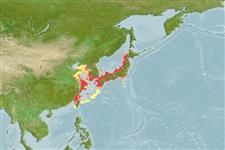Common names from other countries
Environment: milieu / climate zone / depth range / distribution range
экология
морской; пресноводный; солоноватоводный; амфидромный; пределы глубины 30 - ? m (Ref. 10943). Temperate; 34°N - 17°S
Northwest Pacific: Yellow Sea, Pohai Sea, Japan Sea, and the Pacific coast of Japan, extending north to Sakhalin and to Preobrazheniye Bight and Vladivostok in the Gulf of Peter the Great. Recorded from the lower part of the Yangtze River in China. Occurrence of this species south to the Ryukyu Islands and Taiwan needs verification.
Length at first maturity / Size / Вес / Возраст
Maturity: Lm ?, range 17 - ? cm
Max length : 40.0 cm TL самец/пол неопределен; (Ref. 637)
Краткое описание
определительные ключи | морфология | морфометрия
колючие лучи спинного плавника (общее число) : 0; членистые (мягкие) лучи спинного плавника (общее число) : 14 - 18; колючие лучи анального плавника: 0; членистые (мягкие) лучи анального плавника: 15 - 18; позвонки: 59 - 63. Anterior branch of its preorbital canal curved forward at an angle of about 90°. Predorsal scales 66-81; vertebrae 59-63; pectoral fin rays 12-14, usually 13. Lower jaw shorter than head length.
Common in inshore waters. Occurs in the lower part of the Yangtze River in China (Ref. 10943). Forms small schools and feed mainly on zooplankton. Meat delicious. Also caught with dip nets. Used in Chinese medicine (Ref. 12166).
Life cycle and mating behavior
Maturities | размножение | Spawnings | Egg(s) | Fecundities | личинки
Collette, B.B. and J. Su, 1986. The halfbeaks (Pisces, Beloniformes, Hemiramphidae) of the Far East. Proc. Acad. Nat. Sci. Philadelphia 138(1):250-301. (Ref. 10943)
Статус Красного Списка МСОП (Ref. 130435)
CITES (Ref. 128078)
Not Evaluated
Угроза для людей
Harmless
Использование человеком
рыболовство: коммерческий
дополнительная информация
инструменты
Специальные отчеты
Скачать в формате XML
ресурсы в Интернет
Estimates based on models
Preferred temperature (Ref.
115969): 6.9 - 21.7, mean 18.4 (based on 8 cells).
Phylogenetic diversity index (Ref.
82804): PD
50 = 0.5000 [Uniqueness, from 0.5 = low to 2.0 = high].
Bayesian length-weight: a=0.00209 (0.00116 - 0.00377), b=3.07 (2.91 - 3.23), in cm Total Length, based on LWR estimates for this species & Genus-body shape (Ref.
93245).
Trophic level (Ref.
69278): 3.4 ±0.45 se; based on food items.
устойчивость к внешним воздействиям (Ref.
120179): средний (среднего размера), минимальное время удвоения популяции 1.4-4.4 года (Assuming tm=2).
Fishing Vulnerability (Ref.
59153): Low to moderate vulnerability (30 of 100).
Climate Vulnerability (Ref.
125649): Very high vulnerability (76 of 100).
